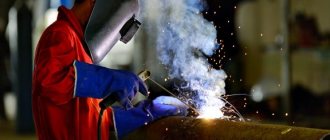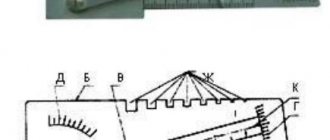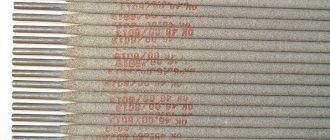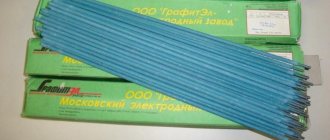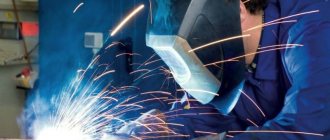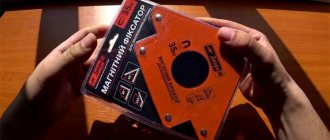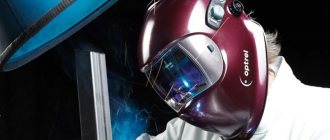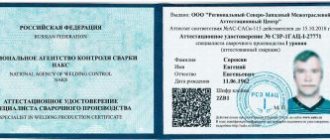Types of gloves
Today, there are mittens and gloves made from several types of materials on sale. There are also combined models made using several materials at once .
- Canvas gauntlets are the least popular because they do not cope very well with the most important task - protecting the hand from high temperatures and sparks during welding. In addition, this material is burned and can even ignite, which can greatly harm the performer’s hands.
- Leggings made from genuine leather are called split leather. These products are highly resistant to high temperatures and flying sparks. Leather that has undergone special treatment is very elastic, durable, hygienic and comfortable. Split leather leggings, equipped with a fleece or cotton layer inside, provide warmth to the hands and allow the skin to breathe.
- Felt products are also very good for welding.
As for the size, welding gaiters can be up to the elbow or cover only the hand. Many models have a special cuff that serves as an additional measure of limb protection.
Handling and care
Work gloves, gloves or mittens must be washed periodically , but the following problems arise:
- Split leather leggings are not suitable for periodic washing.
- Felt and tarpaulin options tolerate similar procedures normally.
- Leather products are treated with special anti-pollution agents to protect them from the negative effects of water.
If you wash split leather leggings, the leather will shrink and you will have to spend time drying, as heating makes the material brittle.
Design
This piece of workwear can be of different modifications - mittens, five-fingered or three-fingered gloves.
- The most popular option is five-fingered welding gaiters. They are very comfortable to use because the fingers and hand can move freely. In addition, the material allows you to provide effective protection even when performing hazardous work.
- Two-fingered models are standard mittens with a thumb, which is located separately. This configuration makes it possible to firmly hold the equipment.
- Combined products involve the use of two different materials. The most vulnerable area - the top - is reinforced with a thick stripe. Often, a tarpaulin is used for this type of gaiter, but thanks to the presence of inserts, the products become much more reliable. This sewing technology can significantly reduce the cost of leggings. The vulnerability of such models is considered to be seams.
Advantages and disadvantages
Split suits have advantages over equipment made from other materials. They have many advantages:
- provide the highest class of protection due to heat resistance;
- high density (on average 550 g/m2) increases resistance to mechanical stress;
- withstand low temperatures, moisture, chemicals;
- have a long service life without performance degradation.
However, there are also some disadvantages. Due to the high density of the material, there is no air exchange. An impermeable all-split suit causes a feeling of discomfort in the worker. In the constant presence of high temperatures, he will feel hot and overheating may occur.
Price
The cost of welding gloves depends on the material used to make them, size and manufacturer..
Canvas models are considered the cheapest, since this material is the most accessible. The most expensive ones are imported split leather.
But the industry was able to find an excellent loophole - combination gloves. They allow you to reduce the cost of production.
The cost of such products varies from one hundred to one and a half thousand rubles.
Additional processing
It is important to note here that gray split leather leggings without lining, without any additional processing or impregnation, can be used in the following temperature range: from -10 to +45 degrees Celsius. However, in order to make them optimal for use by welders, they are most often treated with a special compound
Thanks to this action, the gloves become more protected from splashes of sparks or even hot metal. It is also important to add that after an additional processing process, the temperature limit increases from 45 degrees to 100 degrees Celsius.
Kevlar thread is also used in the production of split leather leggings. It is used for sewing seams on gloves. This material belongs to the para-aramid group. In other words, this thread adds a high margin of strength, and, in itself, has a high fire resistance rating.
How to choose welding gaiters
When choosing leggings, you should pay attention to their main function - protecting the limbs. Also, the products should not restrict the hands, but securely fix the instruments. Split leather leggings are considered the most reliable, however, they are quite expensive.
An important element of gloves is also their internal filler.:
- For use in the cold season, it is better to take an insulated model of welding gloves. The inside of such products is insulated with natural or synthetic fur.
- For use in warm weather, it is recommended to take lightweight variations that are lined with cotton material that allows the brush to “breathe.”
In the process of purchasing welding gloves and mittens, you need to pay attention to all existing seams. At first glance, it may seem that this unimportant element can be overlooked. However, it is very important. It would be great if Kevlar thread was used to make the gloves. This material is characterized by high resistance to temperature changes. It is also very durable and ductile .
If the seams are stitched with lavsan-based thread, then the product must have additional dense inserts.
Combined type gloves should be purchased taking into account the place where welding work will be carried out. This is a great option if you want to save money. Welding performed under the ceiling involves strengthening the bottom of the mitten. The wide edges of the mittens are very convenient for use in winter. These models are very convenient to wear over regular clothes.
Manufacturers of leggings: ranking of the best
Welder's gaiters are an individual thing, and each specialist chooses his “favorite”. Based on reviews from customers and experts from specialty clothing stores, we have compiled a rating of the most popular and popular welding gloves:
- Curved MIG Glove. Manufacturer: Swedish company ESAB. The model is made of specially processed split leather. The gloves perfectly follow the shape of the worker’s hand. They are equipped with durable palm grips and soft padded cuffs. The gloves are suitable for manual and semi-automatic arc welding. Cost – from 1500 rubles.
- Welding gloves "Bars". The Russian manufacturer of the same name is the leader of the domestic market. The gauntlets are made of fire-resistant split leather, they retain their shape, so the worker can remove them at any time. These gloves are also distinguished by their durability, softness and versatility. But wear resistance is lower than that of the leader in our rating. The cost of the model is from 500 rubles. \
- Siberia T30-11-ru. Combined leggings made of specially treated goatskin. Designed specifically for argon arc welding. Such leggings perform their protective function 100% and do not hinder the owner’s movements at all. Among the interesting features are a special cut for the thumb, allowing them to work unhindered, stitching of the seams with Kevlar thread and ultra-thin material. True, gloves are not suitable for other types of welding. It will also be difficult to withstand sub-zero temperatures. The cost of the model is from 500 rubles.
- Optima Plasma Kevlar. Made from premium split leather with cotton lining. The strength of the seams is enhanced by additional stitching with Kevlar thread, which is known for its fire-resistant properties. The disadvantages are that the gloves cannot withstand prolonged contact with hot metal, and the elastic band prevents them from being removed instantly. Cost – from 400 rubles.
- T10 leggings are an option for thrifty and practical people. Protects against all traditional welding hazards, but wears and breaks quickly. It is very easy to stumble upon a fake of this model, so you should only trust certified stores. The cost of gloves is from 200 rubles.
Uniform requirements
Since gauntlets are a separate type of work gloves, they are endowed with certain properties. These include:
- high fire resistance (protection from metal splashes, sparks, etc.);
- strength (tears or punctures are unacceptable);
- durability;
- moisture-repellent properties;
- high-quality tailoring (strength and uniformity of seams, absence of protruding threads);
- presence of insulation (for work in the cold season).
Also, welding gloves must meet certain requirements of European standards. For example, EN 388 (mechanical protection) or EN 407 (temperature resistance). Some mittens are not subject to certification according to these regulatory documents (for example, thin leather or split leather gloves, with the exception of melon gloves). Others are checked according to the following parameters:
- wear resistance;
- puncture resistance;
- cut protection;
- preventing tearing.
Based on tests of welding gaiters for strength, wear resistance and other characteristics, markings with the designation of the standard are applied on top of the products. If you see the designation “EN 388” or “EN 407” on your welding gloves, you can safely use these products.
Classification of welding gloves
The first selection criterion is the material. The shelves of specialized stores are full of various products, but which one should you choose for a particular occasion? The user will encounter three popular materials:
- Tarpaulin. The worst material from a safety point of view. Canvas gaiters burn out very quickly, and the welder runs the risk of getting burned. Designed for auxiliary work, but not for welding. Neoprene or suede mittens have similar “safety.”
- Felt. More reliable than tarpaulin, but also not the best option. If a welder is inclined to buy felt gloves, he should only buy products with special impregnation, which enhances fire resistance and strength.
- Split. The best choice. It is thick leather (pork or beef) treated with a protective compound. This ensures maximum resistance to open fire. As expected, they are more expensive than the previously mentioned analogues.
The second classification criterion is suitability for environmental conditions. For example, there are summer welding gloves (they are thin, in rare cases they have a cotton lining for comfortable wearing) or winter ones. The latter have a layer of insulation inside, which is natural or artificial fur.
The third criterion is the design of products. So they distinguish:
- five-fingered gloves (the most comfortable, versatile; do not limit the mobility of the limbs);
- two- and three-fingered (reduce the load on the hand and are usually used for electric welding with electrodes).
The result of the above is the statement: for any welding work, split-split welding gloves that meet the requirements of European standards are preferable. Insulated products are recommended for work at subzero temperatures.
Materials
When creating split leather leggings, split leather is used as the main material. However, it, in turn, can be very different. The second and third layers of skin are usually much thinner than the first, which adds a number of additional features to them. Gloves made from thin split leather are much more comfortable and skin-friendly, and they do not require lining materials.
Layers of split leather, the thickness of which exceeds 1.2 millimeters, are used to create class A gaiters. Such gaiters are very reliable: they are almost impossible to damage during operation and can withstand temperatures of up to 100 degrees Celsius. Class A gloves may restrict movement slightly, although the effect is almost unnoticeable. In addition, thick split leather is not very pleasant to the touch and can even cause irritation on the skin, which is why such gloves always have an additional layer of fabric lining.
Kevlar thread is most often used to hold gloves together. Dacron threads can also be used, but in this case the manufacturer will be required to reinforce the seam with an additional leather insert. Depending on what kind of leather was used for production, the split leather may turn out to be of different colors. The most common are gray leggings, as well as various shades of yellow, orange and brown.
Some manufacturers coat their gloves with a layer of fire-resistant paint. It not only gives them a more presentable appearance, but can also slightly increase their protective properties. There are also gaiters with a siliconized coating, which makes them completely waterproof. These gloves are widely used for working with liquid nitrogen. There are also models that have increased fire resistance. They are impregnated with a special fire-resistant compound.
Overview of species
There are several types of welder's gloves. The division occurs based on the features of their design.
Five-fingered. As the name implies, these leggings have a separate hole for each of the fingers. This type of gloves is optimal in terms of comfort and convenience. Five-fingered gauntlets do not reduce finger mobility and are considered universal - suitable for all types of installation and welding work. In accordance with the requirements, the leggings are made of split leather with additional leather inserts. The inside of the glove is covered with airtight fabric or fleece. Length according to GOST – 35 centimeters.
They have special textile inserts on the palms and on the back of the hand. The lining for them is made of cotton fabric, and the reinforcement is made of double split leather or tarpaulin. It is worth noting that now most welding gloves are combined. Although, of course, you can find simpler options.
- Increased sleeve length.
- Extended bell for wearing over a winter jacket or overalls.
- Insulated lining made of fur or fabric of increased density.
All this allows you to work comfortably even in very low temperatures.
Rules for caring for mittens
A set of ordinary gloves will cost a welder at least 500 rubles, and more advanced analogues are 2-3 times more expensive. It is unlikely that the user will have the desire to buy a new pair every week, so it will be useful for him to familiarize himself with the maintenance rules for the gloves listed below:
- Regular washing of products. Split fibers wash worse, you will have to tinker with them; canvas or felt ones can easily withstand the procedure.
- Cleaning with chemicals. The same ones you use to clean regular leather products. They will protect welding gloves from moisture penetration and also remove contaminants.
- Dry thoroughly. If liquid remains inside the goggles, the products will conduct heat better, and the welder may get burned during work.
It is important to know that high-quality leather products (especially insulated ones) shrink. However, after final drying, they return to their original appearance.


